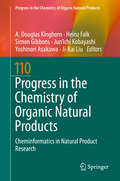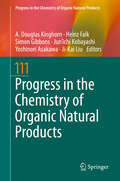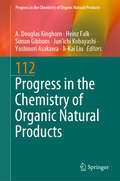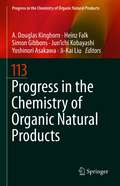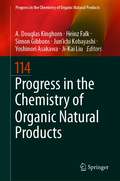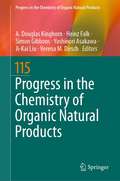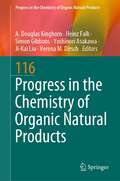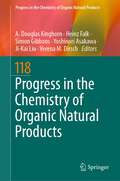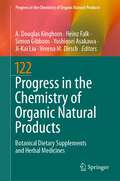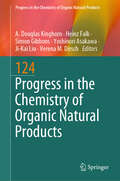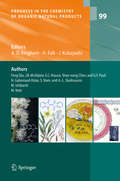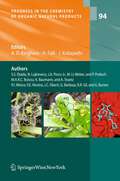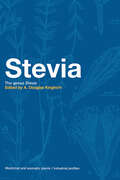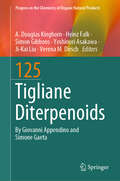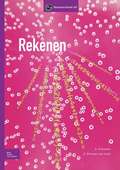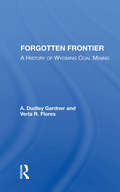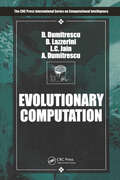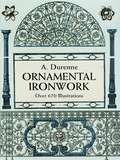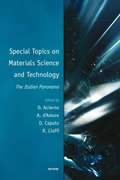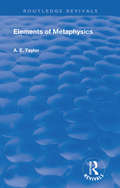- Table View
- List View
Progress in the Chemistry of Organic Natural Products 110: Cheminformatics in Natural Product Research (Progress in the Chemistry of Organic Natural Products #110)
by A. Douglas Kinghorn Heinz Falk Simon Gibbons Yoshinori Asakawa Jun’ichi Kobayashi Ji-Kai LiuThe book summarizes important aspects of cheminformatics that are relevant for natural product research. It highlights cheminformatics tools that help to match natural products with their respective biological targets or off-targets, and discusses the potential and limitations of this approach.
Progress in the Chemistry of Organic Natural Products 111 (Progress in the Chemistry of Organic Natural Products #111)
by A. Douglas Kinghorn Heinz Falk Simon Gibbons Yoshinori Asakawa Jun’ichi Kobayashi Ji-Kai LiuThe first chapter in volume 111 summarizes research on the sesterterpenoids, which are known as a relatively small group of natural products. However, they express a variety of simple to complicated chemical structures. This chapter focuses on the chemical structures of sesterterpenoids and how their structures are synthesized in Nature. The second chapter is devoted to marine-derived fungi, which play an important role in the search for structurally unique secondary metabolites, some of which show promising pharmacological activities that make them useful leads for drug discovery. Marine natural product research in China in general has made enormous progress in the last two decades as described in this chapter on fungal metabolites. This contribution covers 613 new natural products reported from 2001 to 2017 from marine-derived fungi obtained from algae, sponges, corals, and other marine organisms from Chinese waters.
Progress in the Chemistry of Organic Natural Products 112 (Progress in the Chemistry of Organic Natural Products #112)
by A. Douglas Kinghorn Heinz Falk Simon Gibbons Yoshinori Asakawa Jun’ichi Kobayashi Ji-Kai LiuThe first chapter describes the oldest method of communication between living systems in Nature, the chemical language. Plants, due to their lack of mobility, have developed the most sophisticated way of chemical communication. Despite that many examples involve this chemical communication process - allelopathy, there is still a lack of information about specific allelochemicals released into the environment, their purpose, as well as in-depth studies on the chemistry underground. These findings are critical to gain a better understanding of the role of these compounds and open up a wide range of possibilities and applications, especially in agriculture and phytomedicine. The most relevant aspects regarding the chemical language of plants, namely, kind of allelochemicals have been investigated, as well as their releasing mechanisms and their purpose, are described in this chapter. The second chapter is focused on the natural products obtained from Hypericum L., a genus of the family Hypericaceae within the dicotyledones. Hypericum has been valued for its important biological and chemical properties and its use in the treatment of depression and as an antibacterial has been well documented in primary literature and ethnobotanical reports. The present contribution gives a comprehensive summary of the chemical constituents and biological effects of this genus. A comprehensive account of the chemical constituents including phloroglucinol derivatives, xanthones, dianthrones, and flavonoids is included. These compounds show a diverse range of biological activities that include antimicrobial, cytotoxic, antidepressant-like, and antinociceptive effects. The third chapter addresses microtubule stabilizers, which are a mainstay in the treatment of many solid cancers and are often used in combination with molecularly targeted anticancer agents and immunotherapeutics. The taccalonolides are a unique class of such microtubule stabilizers isolated from plants of Tacca species that circumvent clinically relevant mechanisms of drug resistance. Although initial reports suggested that the microtubule stabilizing activity of the taccalonolides is independent of direct tubulin binding, additional studies have found that potent C-22,23 epoxidated taccalonolides covalently bind the Aspartate 226 residue of β-tubulin and that this interaction is critical for their microtubule stabilizing activity. Some taccalonolides have demonstrated in vivo antitumor efficacy in drug-resistant tumor models with exquisite potency and long-lasting antitumor efficacy as a result of their irreversible target engagement. The recent identification of a site on the taccalonolide scaffold that is amenable to modification has provided evidence of the specificity of the taccalonolide-tubulin interaction and the opportunity to further optimize the targeted delivery of the taccalonolides to further improve their anticancer efficacy and potential for clinical development.
Progress in the Chemistry of Organic Natural Products 113 (Progress in the Chemistry of Organic Natural Products #113)
by A. Douglas Kinghorn Heinz Falk Simon Gibbons Yoshinori Asakawa Jun’ichi Kobayashi Ji-Kai LiuIn this book, chemical studies are described mainly from literature reports appearing since 2000, inclusive of investigations performed by the present authors, on the diversity in secondary metabolites of Ligularia growing in the Hengduan Mountains area of China, focusing on eremophilane sesquiterpenoids and other metabolites. More than 100 Ligularia species and their related genera in the plant family Senecioneae plants (Cremanthodium, Cacalia, Senecio, and others) grow in East Asia. For many years, researchers have studied the chemical constituents of these plants, and terpenoids, flavonoids, steroids, alkaloids, and aromatic compounds have been isolated. Among these, in particular, numerous sesquiterpenoids were reported. Within this book terpenoids and aromatic compounds (total 1049), both previously unknown and known, are presented. Finally, genetic studies and synthesis investigations are briefly reviewed.
Progress in the Chemistry of Organic Natural Products 114 (Progress in the Chemistry of Organic Natural Products #114)
by A. Douglas Kinghorn Heinz Falk Simon Gibbons Yoshinori Asakawa Jun’ichi Kobayashi Ji-Kai LiuThis book describes current understandings and recent progress in four areas: in the first one, the cytochalasans, a group of fungal derived natural products characterized by a perhydro-isoindolone core fused with a macrocyclic ring are shown to exhibit high structural diversity and a broad spectrum of bioactivities. The second one is dedicated to a description of bioactive compounds from the medicinal plants of Myanmar, the third one is dedicated to new structure elucidation techniques in the field of sesquiterpenes. The last one discusses the endogenous natural products that are produced by human cells including endogenous amines, steroids, and fatty acid derived natural products. The co-metabolism and natural product production of the human microbiome is also described including tryptophan, bile acids, choline, and cysteine.
Progress in the Chemistry of Organic Natural Products 115 (Progress in the Chemistry of Organic Natural Products #115)
by A. Douglas Kinghorn Heinz Falk Simon Gibbons Yoshinori Asakawa Ji-Kai Liu Verena M. DirschThis book describes current understandings and recent progress into a varied group of natural products. In the first chapter the role that total synthesis may play in revising the structures proposed for decanolides, which are ten-membered lactones found primarily in fungi, frogs, and termites is presented. The following chapter presents the development of the intriguing plant-derived sesquiterpene lactone, thapsigargin, a potent inhibitor of the enzyme, SERCA (sarco-endoplasmic Ca2+ ATPase), which has potential as a lead compound to treat cancer. The third chapter covers the potential of various plant phenolic compounds for treating the tropical and sub-tropical infectious disease, leishmaniasis. In addition the volume presents recent advances related to the plant alkaloid, cryptolepine, which is of particular interest as a lead for the treatment of malaria, trypanosomiasis, and cancer.
Progress in the Chemistry of Organic Natural Products 116 (Progress in the Chemistry of Organic Natural Products #116)
by A. Douglas Kinghorn Heinz Falk Simon Gibbons Yoshinori Asakawa Ji-Kai Liu Verena M. DirschThis volume describes several highly diverse subjects: Chapter 1 explores marine biodiscovery of the North-eastern Atlantic off the coast of Ireland as a model for best practice in research. The second chapter investigates Brazilian Chemical Ecology and examples of insect-plant communication studies that are mediated by natural products demonstrate the beautiful interconnectedness of species in a biome. Our third chapter comprises the advances in the science of the sesquiterpene quinone, perezone, which in 1852 was the first natural product isolated in crystalline form in the New World. The last two chapters are from a Vietnamese group and the first of these follows the phytochemistry, pharmacology, and ethnomedical uses of the genus Xanthium, which produces interesting sulfur and nitrogen containing natural products. Finally, the genus Desmos is discussed, where an overview of its constituent natural products and their in vitro pharmacological potential is described.
Progress in the Chemistry of Organic Natural Products 118 (Progress in the Chemistry of Organic Natural Products #118)
by A. Douglas Kinghorn Heinz Falk Simon Gibbons Yoshinori Asakawa Ji-Kai Liu Verena M. DirschThis volume consists of four chapters that cover a structurally diverse range of naturally occurring compounds. Chapter 1 delves into the chemistry of pyrogallols and their oxidized products, the hydroxy-o-quinones, including their role in cycloaddition reactions in the chemical synthesis of several fungal metabolites. Chapter 2 provides an in-depth description of the constituents of agarwood essential oil and smoke samples that are used in the perfumery industry, with an emphasis on the sesquiterpenoid and chromones constituents so far known. Chapter 3 discusses the defensive chemical ecology of two North American newt species that both produce tetrodotoxin, a well-known neurotoxin that causes paralysis and death in metazoans by disrupting electrical signals in the nerves and muscles. Chapter 4 discusses the limonoids and triterpenoids from the genus Walsura of the plant family Meliaceae, of which a number of species are utilized in several southeastern Asian countries in systems of folk medicine.
Progress in the Chemistry of Organic Natural Products 122: Botanical Dietary Supplements and Herbal Medicines (Progress in the Chemistry of Organic Natural Products #122)
by A. Douglas Kinghorn Heinz Falk Simon Gibbons Yoshinori Asakawa Ji-Kai Liu Verena M. DirschThis volume highlights some recent developments on plants used widely as botanical dietary supplements and herbal medicines, especially in terms of knowledge of the chemical types and diverse biological activities of their constituents, as well as laboratory approaches for their quality control and taxonomic identification. In the first chapter, the biologically active secondary metabolites are described of selected botanicals that have a wide current use in the United States, with recent information provided also on their in vitro and in vivo biological activities. The second chapter constitutes an updated survey of the different chromatographic, spectroscopic, and metabolomics techniques that can be utilized for the quality control of botanical products. The penultimate chapter covers different nomenclatural systems that are of use for the taxonomic identification of source plants used in botanical products. Finally, deoxyribonucleic acid molecular barcoding techniques for the identification for plants used as dietary supplements are covered.
Progress in the Chemistry of Organic Natural Products 124 (Progress in the Chemistry of Organic Natural Products #124)
by A. Douglas Kinghorn Heinz Falk Simon Gibbons Yoshinori Asakawa Ji-Kai Liu Verena M. DirschThis volume presents three chapters discussing a range of topics. Chapter 1 deals with the development of efficient methods for compound dereplication that have been critical in the re-emergence of research on natural products as a source of new drug leads. It describes the main methods of dereplication, which rely on the combined use of large natural product databases and spectral libraries, alongside the information obtained from chromatographic, UV-Vis, MS, and NMR spectroscopic analyses of the samples of interest. Chapter 2 describes 989 plant natural products and their ecological functions in plant-herbivore, plant-microorganism, and plant-plant interactions. These compounds include alkaloids, phenols, terpenoids, and other structural types. The information presented should provide the basis for in-depth research on these plant natural products and their natural functions, and also for their further development and utilization. Chapter 3 focuses on lichens, with each constituting a symbiotic association composed of a primary mycobiont and one or more photobionts living mutualistically. Covered are lichens and their bionts, taxonomic identification, and their chemical constituents as exemplified by what is found in lichen biomes, especially those endemic to North America. Extraction and isolation procedures, as well as updates on dereplication methods using mass spectrometric GNPS and NMR spectroscopic spin network fingerprint procedures, and marker-based techniques to identify lichens are discussed. The isolation and structure elucidation of secondary metabolites of an endolichenic Penicillium species that produces bioactive compounds is described in detail.
Progress in the Chemistry of Organic Natural Products 99
by A. Douglas Kinghorn H. Falk J. KobayashiThe volumes of this classic series, now referred to simply as "Zechmeister" after its founder, Laszlo Zechmeister, have appeared under the Springer Imprint ever since the series' inauguration in 1938. The series has featured contributions by seven Nobel laureates: D. H. R. Barton, D. Crowfoot Hodgkin, L. Pauling, K. Alder, O. Diels, P. Karrer, H. von Euler-Chelpin. The volumes contain contributions on various topics related to the origin, distribution, chemistry, synthesis, biochemistry, function or use of various classes of naturally occurring substances ranging from small molecules to biopolymers. Each contribution is written by a recognized authority in the field and provides a comprehensive and up-to-date review of the topic in question. Addressed to biologists, technologists, and chemists alike, the series can be used by the expert as a source of information and literature citations and by the non-expert as a means of orientation in a rapidly developing discipline.
Progress in the Chemistry of Organic Natural Products Vol. 94
by A. Douglas Kinghorn Heinz Falk Junichi KobayashiThe three reviews cover the advances in the chemistry and biology of withanolides over the last 16 years, review the chemistry and biology of the rocaglamide-type derivatives and related compounds, with emphasis on their structural diversity, biosynthesis, pharmacological significance and total synthesis, and summarize the extensive chemistry and biology studies on a natural product, which have resulted in a novel therapy approved worldwide.
Stevia: The Genus Stevia
by A. Douglas KinghornStevia rebaudiana is a remarkable South American plant that has become widely used in certain parts of the world as a natural sweetening agent and dietary supplement. Purified extracts of S. rebaudiana have been used as sweeteners and flavor enhancers in the food industry in Japan for over a quarter of a century, and have been found to be up to 300
Tigliane Diterpenoids (Progress in the Chemistry of Organic Natural Products #125)
by A. Douglas Kinghorn Heinz Falk Simon Gibbons Yoshinori Asakawa Ji-Kai Liu Verena M. DirschThis book reviews the distribution, chemistry, and molecular bioactivity of tiglianes from the very beginning of the studies on these diterpenoids. It provides a summary of their clinical and toxicological literature mostly in its more recent and controversial aspects, while critically analyzing various proposals for their biosynthesis.
Einstein and the Quantum: The Quest of the Valiant Swabian
by A. Douglas StoneThe untold story of Albert Einstein's role as the father of quantum theoryEinstein and the Quantum reveals for the first time the full significance of Albert Einstein's contributions to quantum theory. Einstein famously rejected quantum mechanics, observing that God does not play dice. But, in fact, he thought more about the nature of atoms, molecules, and the emission and absorption of light—the core of what we now know as quantum theory—than he did about relativity.A compelling blend of physics, biography, and the history of science, Einstein and the Quantum shares the untold story of how Einstein—not Max Planck or Niels Bohr—was the driving force behind early quantum theory. It paints a vivid portrait of the iconic physicist as he grappled with the apparently contradictory nature of the atomic world, in which its invisible constituents defy the categories of classical physics, behaving simultaneously as both particle and wave. And it demonstrates how Einstein's later work on the emission and absorption of light, and on atomic gases, led directly to Erwin Schrödinger's breakthrough to the modern form of quantum mechanics. The book sheds light on why Einstein ultimately renounced his own brilliant work on quantum theory, due to his deep belief in science as something objective and eternal.
The Dealings of Captain Sharkey / and Other Tales of Pirates (Classics To Go)
by A. DoyleSir Arthur Ignatius Conan Doyle (22 May 1859 – 7 July 1930) was a Scottish writer and physician, most noted for his fictional stories about the detective Sherlock Holmes, which are generally considered milestones in the field of crime fiction. This is a collection of short stories. (Excerpt from Wikipedia)
Illinois: A Geography
by A. Doyne HorsleyHorsley focuses on the contrasting environments within the state of Illinois and on the interactions of the inhabitants with their surroundings. He uses a standard Progressing from the physical and historical factors, through economic activities, concluding with chapters on Chicago and its suburbs. The text includes an urban-rural traverse across the state and a series of maps on presidential voting records by counties, 1960 to 1984.
Rekenen
by D. Hulst A. DriessensRekenen in de zorg levert een bijdrage aan de rekenkundige vaardigheden van verpleegkundigen en verzorgenden. Het bevat een algemeen overzicht van basisberekeningen, zoals het schattend rekenen Ook het kunnen lezen van getallen in exponenten, die soms op uitslagenformulieren voorkomen, wordt in het boek behandeld. Een belangrijk deel van dit boek is het hoofdstuk 'Beroepsspecifiek rekenen'. Het omvat vooral de berekeningen die ten grondslag liggen aan het werken met oplossingen en verdunningen die voorkomen bij infusen en injecties. Ook het werken met gassen (met name zuurstof) komt in dit boek aan bod. Rekenen in de zorg nodigt uit tot zelfwerkzaamheid. Alle antwoorden op de vraagstukken staan achteraan in het boek. Het antwoord op de vragen is dan ook niet de sleutel. De weg er naar toe wél. 'Trucjes' zijn zoveel mogelijk achterwege gelaten. Het gaat tenslotte om het helder bedenken van de oplossing van de vraagstukken. Dit rekenboek is bestemd voor mbo-studenten verpleegkunde en verzorgenden.
Rekenen in de zorg
by A. Driessens D. Brouwer-van HulstRekenen in de zorg levert een bijdrage aan de rekenkundige vaardigheden van verpleegkundigen en verzorgenden. Het bevat een algemeen overzicht van basisberekeningen, zoals het schattend rekenen Ook het kunnen lezen van getallen in exponenten, die soms op uitslagenformulieren voorkomen, wordt in het boek behandeld. Een belangrijk deel van dit boek is het hoofdstuk 'Beroepsspecifiek rekenen'. Het omvat vooral de berekeningen die ten grondslag liggen aan het werken met oplossingen en verdunningen die voorkomen bij infusen en injecties. Ook het werken met gassen (met name zuurstof) komt in dit boek aan bod. Rekenen in de zorg nodigt uit tot zelfwerkzaamheid. Alle antwoorden op de vraagstukken staan achteraan in het boek. Het antwoord op de vragen is dan ook niet de sleutel. De weg er naar toe w#65533;l. 'Trucjes' zijn zoveel mogelijk achterwege gelaten. Het gaat tenslotte om het helder bedenken van de oplossing van de vraagstukken. Dit rekenboek is bestemd voor mbo-studenten verpleegkunde en verzorgenden.
Rekenen in de zorg voor niveau 3–4
by A. Driessens D. Brouwer-van HulstRekenen in de zorg levert een bijdrage aan de rekenkundige vaardigheden van verpleegkundigen en verzorgenden. Het bevat een algemeen overzicht van basisberekeningen, zoals het schattend rekenen Ook het kunnen lezen van getallen in exponenten, die soms op uitslagenformulieren voorkomen, wordt in het boek behandeld. Een belangrijk deel van dit boek is het hoofdstuk 'Beroepsspecifiek rekenen'. Het omvat vooral de berekeningen die ten grondslag liggen aan het werken met oplossingen en verdunningen die voorkomen bij infusen en injecties. Ook het werken met gassen (met name zuurstof) komt in dit boek aan bod. Rekenen in de zorg nodigt uit tot zelfwerkzaamheid. Alle antwoorden op de vraagstukken staan achteraan in het boek. Het antwoord op de vragen is dan ook niet de sleutel. De weg er naar toe wél. 'Trucjes' zijn zoveel mogelijk achterwege gelaten. Het gaat tenslotte om het helder bedenken van de oplossing van de vraagstukken. Dit rekenboek is bestemd voor mbo-studenten verpleegkunde en verzorgenden.
Forgotten Frontier: A History Of Wyoming Coal Mining
by A. Dudley GardnerThis work reflects part of the history of Wyoming coal mining. Much more needs to be written. To those that have produced written histories, historical overviews, and manuscripts we cited here, we extend thanks. To the archaeologists and historians who are studying Wyoming's past and attempting to preserve its lasting legacy, we applaud your efforts. The flight of time is not complete, but the history that has passed shows coal miners will be a part of the future. To those that are attempting to preserve the mining history of Wyoming and the West, we are grateful. And to men such as Steven Creasman and Gary Beach, who have the courage to dream and the willingness to persevere in attempting to save America's past, thank you. With the help of such unselfish individuals this work has been strengthened, but the responsibilities of accuracy fall to the authors alone.
Evolutionary Computation (International Series on Computational Intelligence)
by D. Dumitrescu Beatrice Lazzerini Lakhmi C. Jain A. DumitrescuRapid advances in evolutionary computation have opened up a world of applications-a world rapidly growing and evolving. Decision making, neural networks, pattern recognition, complex optimization/search tasks, scheduling, control, automated programming, and cellular automata applications all rely on evolutionary computation. Evolutionary Com
Ornamental Ironwork: Over 670 Illustrations (Dover Pictorial Archive)
by A. DurenneFinely detailed illustrations, selected from rare turn-of-the-century sources, provide striking examples of decorative ironwork designed to embellish balconies, gates, window grilles, staircases, doorways, and other architectural features. A rich source of inspiration and elegant, royalty-free material for graphic artists, designers, and craftworkers.
Special Topics on Materials Science and Technology - The Italian Panorama
by D. Caputo D. Acierno A. D’Amore R. CioffiThis volume collects selected papers presented and discussed during the 9th National Conference organized by the Italian Association of Materials Engineering, AIMAT from 2008 at Piano di Sorrento (Napoli, Italy). It gives a valuable representation of highlights of the research and development activities running in 21 Italian universities and resear
Elements of Metaphysics (Routledge Revivals)
by A. E TaylorFirst published in 1903, Taylor endeavours to provide a detailed study of metaphysic as a discipline. Opening with a brief history of metaphysics, the book explores topics including the problem of the metaphysician, the metaphysical method, subdivisions of metaphysics, ontology, reality, cosmology, rational psychology, morality, ethics and religion.
